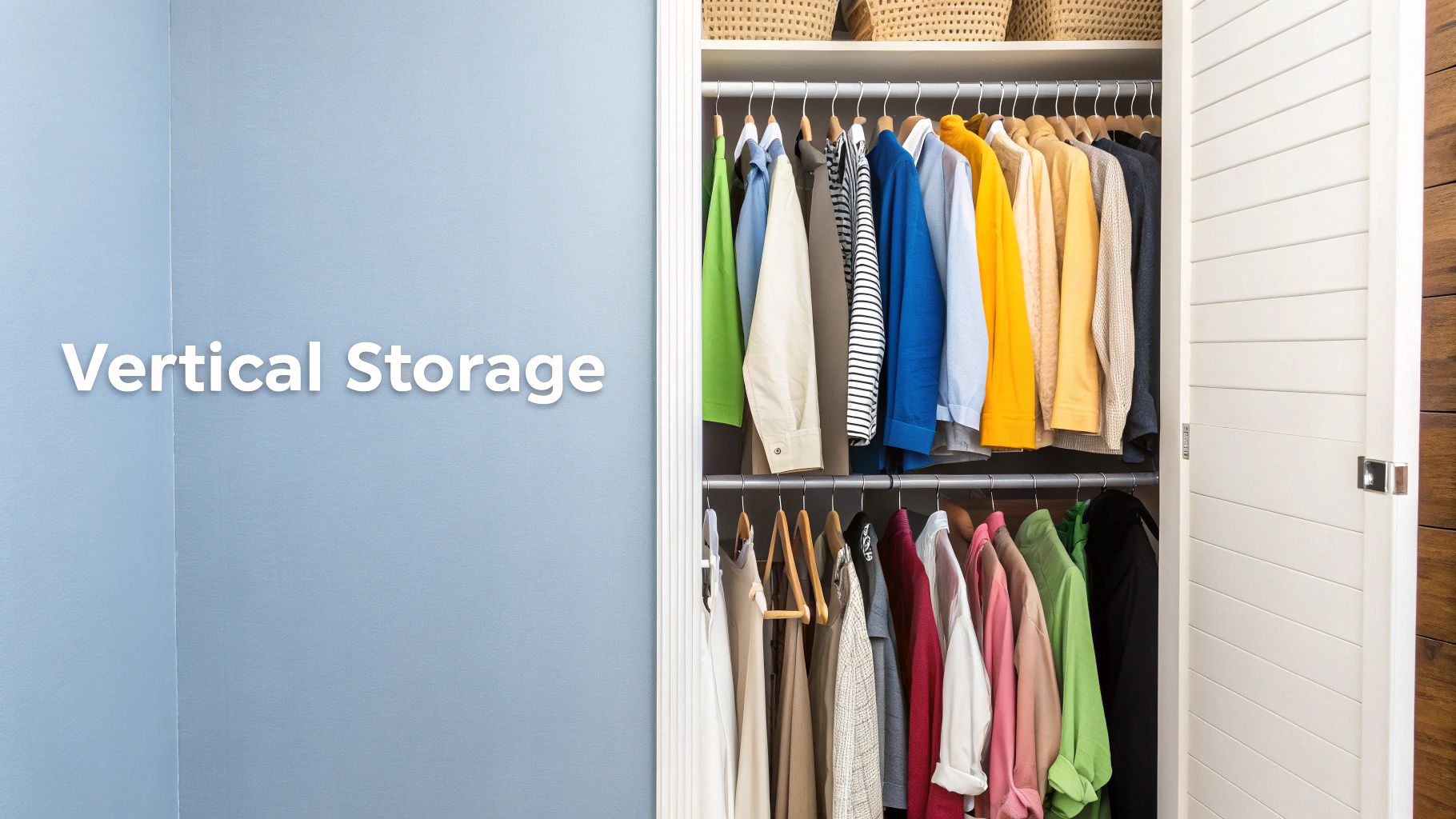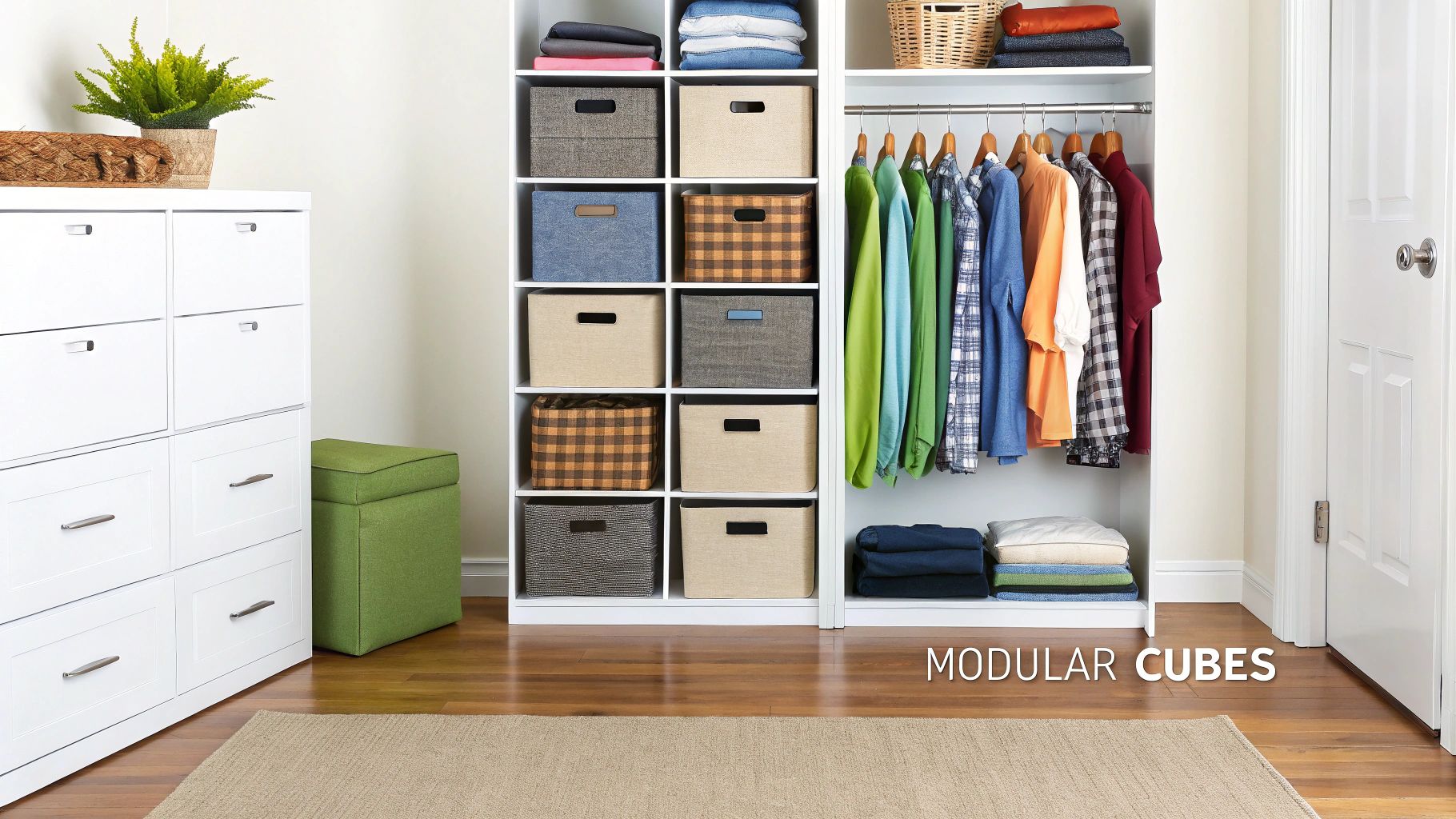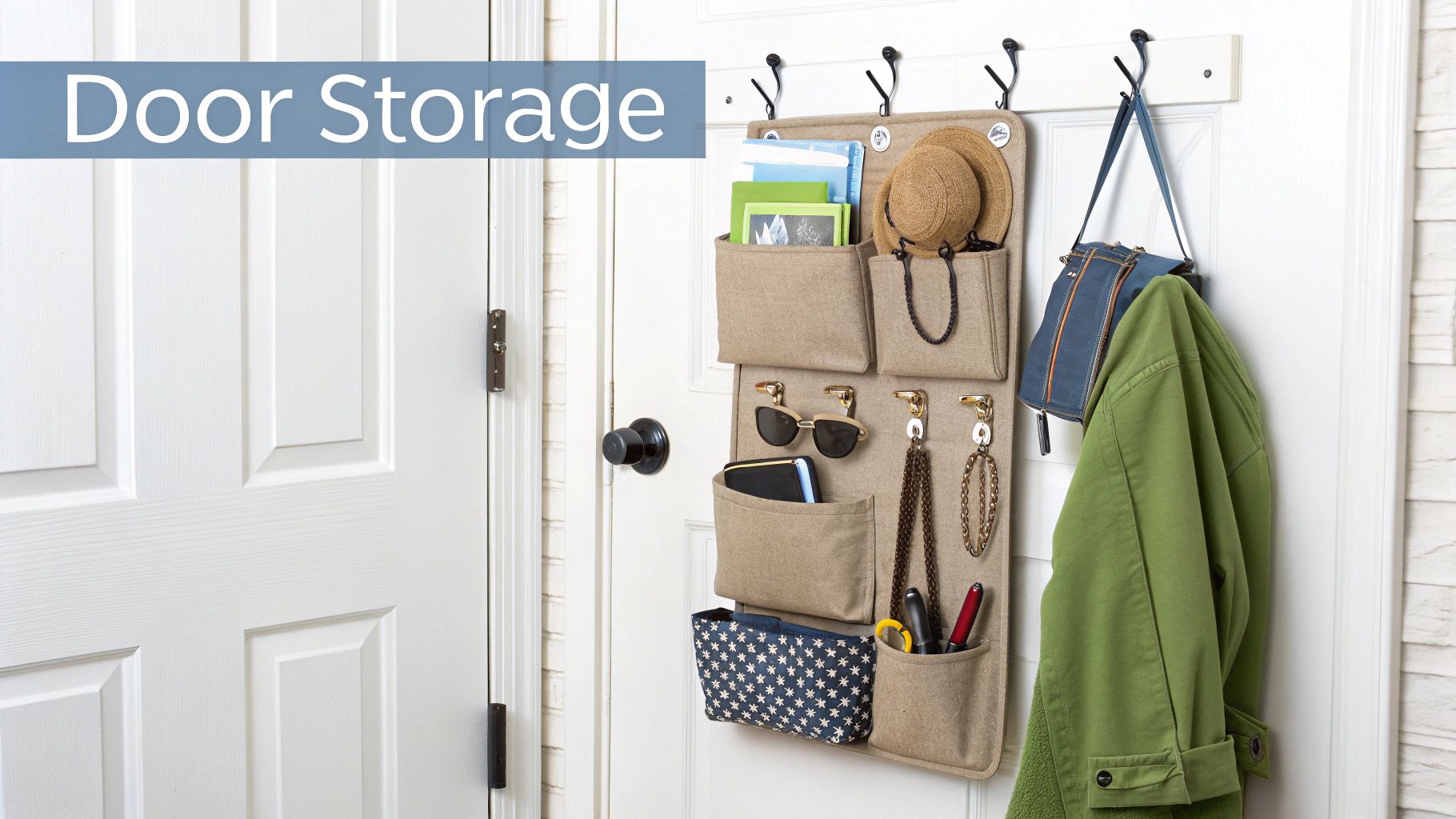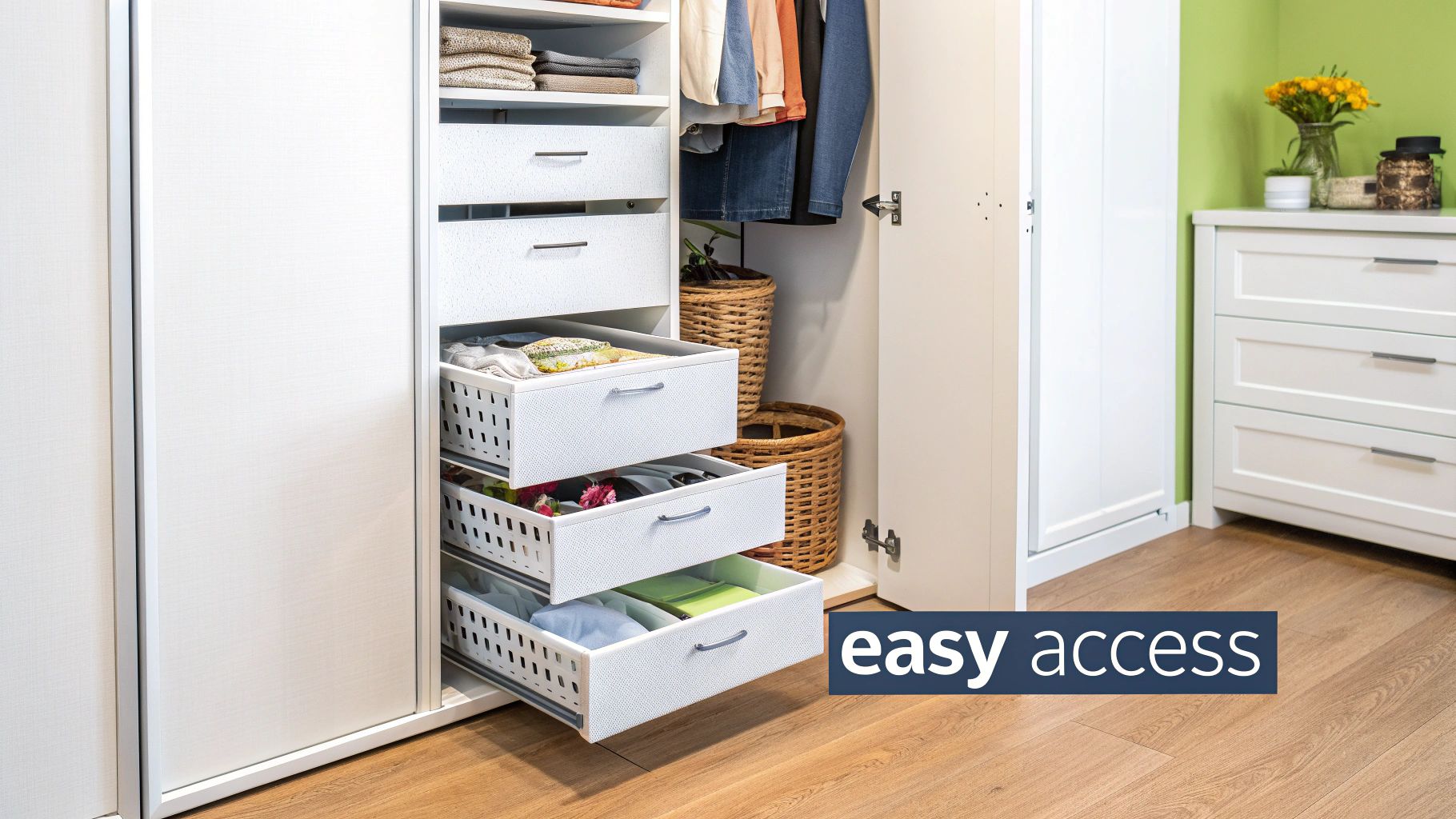6 Genius Narrow Closet Organization Ideas for 2025

A narrow closet can feel like an unsolvable puzzle, a source of clutter where finding what you need is a daily challenge. But that slim space holds untapped potential for perfect organization. Many people resign themselves to a cramped, chaotic wardrobe, unaware that strategic solutions can completely transform it. The key isn't more space, but smarter space. A disorganized narrow closet leads to wrinkled clothes and a stressful start to your day, while a well-organized one streamlines your routine and protects your wardrobe.
This guide moves beyond generic advice to offer six innovative, actionable narrow closet organization ideas. We will explore specific systems designed to maximize every vertical inch and hidden corner. You will learn how to implement vertical hanging systems, modular shelving, over-the-door solutions, and pull-out features to create a highly functional and accessible space. Get ready to turn your most challenging storage area into a model of efficiency. We'll start with a fundamental shift in how you view your closet's layout, using specialized space-saving hangers that can instantly multiply your capacity and bring order to even the most restrictive dimensions.
1. Vertical Hanging Systems with Cascading Hangers
One of the most effective narrow closet organization ideas is to stop thinking horizontally and start utilizing vertical space. Vertical hanging systems, powered by cascading hangers, transform unused air space into tiered, high-density storage. This method allows you to hang multiple garments in the same vertical column, effectively multiplying your hanging capacity without expanding the closet's footprint. It's a game-changer for anyone struggling with limited rod length.

This approach is brilliant for small apartments or dorms where a standard two-foot-wide closet needs to accommodate an entire wardrobe. By cascading hangers, you can fit upwards of 50 items in a space that would traditionally hold only a dozen. It’s also a key strategy in professional closet renovations, where designers use it to triple the hanging capacity of narrow sections dedicated to specific clothing types like shirts or pants.
How to Implement a Vertical Hanging System
Getting started is simple. The core component is a "hanger connector" or a specially designed cascading hanger that allows another hanger to hook onto it. This creates a chain effect, with each garment hanging slightly below the previous one.
- Choose the Right Hangers: Start with a set of uniform, slim velvet hangers. Their non-slip surface keeps clothes in place, and their thin profile is essential for maximizing space.
- Group Similar Items: Create cascades of like items. A chain for blouses, another for trousers, and a third for skirts. This keeps your closet organized and makes finding specific pieces effortless.
- Maintain Proper Spacing: To avoid a cluttered look and ensure clothes don't get wrinkled, leave one to two inches of vertical space between each tier.
- Manage Closet Capacity: Implement the 'one-in-one-out' rule. When you add a new item, an old one must go. This prevents the system from becoming overloaded, which is key to maintaining a functional narrow closet.
Pro-Tip: For a non-permanent solution in rental apartments, install a second tension rod below your main rod to create another full level of hanging space before you even start cascading.
Why This Method Works for Narrow Closets
Vertical systems directly combat the primary limitation of a narrow closet: restricted horizontal rod space. By shifting the storage axis from horizontal to vertical, you tap into the closet’s full height. The organized, tiered structure keeps every item visible and accessible, preventing garments from getting lost in a cramped, overstuffed space. While you're optimizing your closet, you might also be wondering about the best way to handle your extra hangers. You can explore a variety of methods for keeping your spare hangers tidy and accessible to complete your organization project.
To see this space-saving technique in action, check out the video below:
2. Modular Cube and Shelf Inserts
When hanging space isn't the only challenge, narrow closet organization ideas must include solutions for folded clothes, shoes, and accessories. Modular cube and shelf inserts offer a customizable framework, transforming a single, awkward vertical space into a highly organized grid. This approach allows you to build a storage system tailored precisely to your belongings and the unique dimensions of your closet, no matter how slender it is.

This method is incredibly effective in narrow builder-grade closets that often come with just a single rod and a high, unusable shelf. By inserting a stack of modular cubes, you can create dedicated compartments for sweaters, jeans, and handbags, preventing piles from toppling over. For closets as narrow as 18 inches, systems like IKEA's BOAXEL or Elfa's modular solutions create functional, floor-to-ceiling storage where traditional dressers won't fit.
How to Implement a Modular Cube System
Building your custom storage unit is straightforward. The key is precise planning before purchasing any components. This ensures every inch of your limited space is used effectively.
- Measure Everything: Before you buy, measure the closet's interior width, depth, and height. These measurements are crucial for selecting modules that fit perfectly without wasted space.
- Start with a Basic Configuration: Begin with a simple tower of cubes or a few shelves. You can live with this setup for a bit to see how it works and then add more modules, drawers, or dividers as your needs become clearer.
- Use Bins for Containment: Place clear or fabric bins inside the cubes to group smaller items like socks, scarves, or belts. This keeps things tidy and makes it easy to pull out an entire category at once.
- Label Everything: To maintain order, especially if the closet is shared, use labels for each cube or bin. This helps everyone know where items belong and makes finding things quicker.
Pro-Tip: Install battery-operated, motion-sensor puck lights inside deeper cubes. This small addition makes a huge difference in visibility, preventing items from getting lost in the dark recesses of a narrow closet.
Why This Method Works for Narrow Closets
Modular systems are the ultimate problem-solvers for the non-uniform storage needs within a narrow closet. While hanging systems handle shirts and dresses, cubes and shelves create designated homes for everything else. This compartmentalization prevents the floor from becoming a dumping ground for shoes and bags. The flexibility to reconfigure the system as your wardrobe changes ensures it remains a long-term, functional solution, maximizing every square inch from the floor up.
3. Over-the-Door Multi-Functional Storage
One of the most overlooked yet powerful narrow closet organization ideas involves claiming the vertical real estate on the back of your closet door. Over-the-door storage systems transform this blank surface into a multi-functional powerhouse, providing dedicated homes for accessories, shoes, and small items that would otherwise clutter your limited shelf or floor space. This strategy is essential in narrow closets where interior space is at an absolute premium.

This method is frequently championed by professional organizers, who use it to instantly declutter clients' spaces. It’s also a lifesaver for apartment dwellers, as it adds significant storage capacity without drilling holes or making permanent changes. Imagine a clear shoe organizer, traditionally for footwear, being repurposed to hold scarves, belts, and craft supplies, all visible and within easy reach. This simple hack makes finding accessories effortless, streamlining your morning routine.
How to Implement Over-the-Door Storage
Activating this space is straightforward and highly customizable. Most systems simply hook over the top of the door, requiring no tools for installation.
- Choose Versatile Organizers: Opt for organizers with clear pockets. This allows you to see the contents at a glance, eliminating the need to rummage through bins or drawers.
- Distribute Weight Evenly: When loading your organizer, place heavier items like shoes or bulky accessories in the lower pockets and lighter items like scarves or socks towards the top. This prevents the door from becoming top-heavy and difficult to operate.
- Check Your Clearance: Before purchasing, measure the space between your door and the closet frame. Select a shallow organizer that won’t prevent the door from closing completely.
- Declutter Regularly: The visibility of door storage makes it easy to see what you own. Use this to your advantage by regularly purging items you no longer use to prevent overloading and maintain order.
Pro-Tip: For organizers holding heavier items, place a couple of adhesive Command strips on the back to stick it to the door. This will prevent it from swinging and banging every time you open or close the closet.
Why This Method Works for Narrow Closets
Over-the-door storage directly addresses the lack of surface area in a narrow closet. By moving smaller, disparate items from shelves, drawers, or the floor onto the door, you free up critical space for larger clothing items like sweaters and pants. It compartmentalizes your accessories, making every inch of your closet work harder. This approach ensures that no potential storage area is wasted, turning an often-forgotten surface into one of your most valuable organizational assets.
4. Seasonal Rotation Storage System
A powerful strategy among narrow closet organization ideas is to treat your closet not as a permanent archive but as a dynamic, active wardrobe. A seasonal rotation storage system is a strategic approach that involves storing off-season clothing and accessories elsewhere, leaving only currently relevant items in your narrow closet. This method effectively doubles your usable space by removing bulky sweaters in summer and sundresses in winter, preventing clutter and making daily outfit selection much faster.

This system is a cornerstone for minimalist lifestyles and capsule wardrobes. Professional organizers frequently implement this for clients in small city apartments where every inch counts. It’s also a proven method for those who must adapt their wardrobes to different climates, ensuring their immediate closets are always practical and uncluttered.
How to Implement a Seasonal Rotation System
Implementing this system requires a bit of planning, but the payoff in closet space and daily convenience is enormous. The goal is to make the transition between seasons smooth and efficient.
- Schedule Your Switch: Set calendar reminders twice a year (e.g., in April and October) to swap your wardrobes. Treating it as a scheduled event makes it a consistent habit.
- Use Proper Storage: Invest in clear, stackable bins or under-bed storage containers for off-season items. For items that can withstand compression, like puffer jackets, vacuum-sealed bags are excellent space-savers.
- Keep Transitional Pieces Accessible: Don't store everything away. Keep a few versatile items like light cardigans, jeans, and basic tees accessible year-round to handle unpredictable weather.
- Document and Declutter: Take a quick photo of the contents of each storage bin before sealing it. This creates a visual inventory. Use the seasonal switch as a perfect opportunity to get rid of items you didn't wear, a key step in any guide on how to declutter your closet.
Pro-Tip: Before storing clothes for several months, make sure they are clean. Stains can set over time, and subtle odors can attract pests.
Why This Method Works for Narrow Closets
The seasonal rotation system directly addresses the core problem of a narrow closet: a lack of volume. By removing 50% or more of your wardrobe from the primary space at any given time, you drastically reduce density. This creates breathing room, prevents clothes from being crushed, and makes every single item visible and easy to access. Instead of fighting with a jam-packed rod every morning, you are presented with a curated, season-appropriate selection, transforming a stressful space into a functional and organized one.
5. Pull-Out Drawer and Sliding Systems
A major challenge with narrow closets is the deep, dark, and often inaccessible space at the back. Pull-out drawer and sliding systems are fantastic narrow closet organization ideas that directly solve this problem. Instead of fixed shelves where items get lost, this method uses dynamic, sliding components that bring the contents of your closet out to you. This ensures every inch of your closet is usable and every item is easily reachable.
This approach is heavily utilized by custom closet companies like California Closets and made accessible through modular systems like IKEA's PAX wardrobe. These systems are perfect for master bedroom closets where you need to store folded sweaters, jeans, or accessories without them becoming a jumbled pile. By installing sliding baskets or full-extension drawers, a deep and narrow space transforms from a "black hole" into highly efficient, organized storage.
How to Implement a Pull-Out Drawer and Sliding System
Integrating a sliding system can range from a simple DIY project to a full custom installation. The key is to choose components that fit your specific closet dimensions and storage needs.
- Select the Right Components: Choose from pull-out wire baskets for items that need ventilation (like gym clothes), solid drawers for folded items, or specialized sliding racks for pants, ties, or shoes.
- Invest in Quality Hardware: The smoothness and durability of your system depend on the drawer slides. Opt for full-extension slides to ensure you can see and access everything in the drawer, and consider soft-close features for a quiet, premium feel.
- Plan Drawer Heights: Before installing, measure the items you plan to store. A drawer for T-shirts will need less vertical space than one for bulky sweaters. Customizing heights maximizes your available space.
- Enhance Visibility: Install battery-operated or hardwired LED strip lighting along the inside of the closet frame or under shelves. This illuminates the contents of each drawer as you pull it out, making it easy to find what you're looking for.
Pro-Tip: Measure the interior width and depth of your closet carefully before purchasing any pull-out system. Account for door hinges or any other obstructions that could interfere with the sliding mechanism.
Why This Method Works for Narrow Closets
Sliding systems eliminate the "reach-in" problem inherent in narrow closets. By bringing storage forward, they prevent you from having to dig through layers of clothes to find something at the back. This full accessibility means no space is wasted. The structured nature of drawers and baskets also forces you to categorize items, leading to a more organized and visually appealing closet. You can discover more strategies on how to make a small closet feel bigger and more functional.
To see how pull-out systems can revolutionize a closet, check out the video below:
6. Color-Coded Zone Organization
Visual clarity is one of the most powerful narrow closet organization ideas, and a color-coded zone system is the ultimate expression of this principle. This method involves assigning specific colors to different categories of items or even to different family members, creating distinct visual "zones" within the closet. This systematic approach ensures every item has a designated home, making it instantly findable and effortless to put away, which is critical in a tight space where clutter can quickly take over.
This strategy is highly effective in shared family closets, where each person is assigned a color for their hangers, bins, and accessories, preventing mix-ups. Professional organizers frequently use this technique to transform chaotic spaces into streamlined, intuitive systems. It’s also the secret behind the aesthetically pleasing, boutique-style closets seen on social media, where garments are arranged in a beautiful color gradient, turning storage into a design feature.
How to Implement Color-Coded Zones
Creating a color-coded system is a straightforward process focused on visual association. The goal is to train your brain to link a color with a specific category, making organization second nature.
- Assign Colors Systematically: Decide on your zones first. You can assign colors by item type (e.g., blue hangers for shirts, green for pants) or by person in a shared closet. Create a simple reference chart and post it inside the closet door.
- Use Coordinated Supplies: Invest in colored hangers, storage bins, shelf dividers, and labels. Using consistent brands and shades creates a uniform, high-end look that enhances the system's effectiveness.
- Start with Broad Categories: Begin by sorting your wardrobe into major groups like "work clothes," "casual wear," and "formal attire." You can then create more detailed sub-zones within these larger categories.
- Document Your Progress: Take 'before' and 'after' photos. Seeing the visual transformation will motivate you to maintain the system and appreciate the order you’ve created.
Pro-Tip: For a subtle approach, use small colored dot stickers on your existing hangers or label clips on bins instead of buying all new supplies. This is a budget-friendly way to test the system.
Why This Method Works for Narrow Closets
A narrow closet’s biggest weakness is its lack of visual depth, causing items to get lost behind one another. A color-coded system brings order to this visual chaos. By creating distinct, easily identifiable zones, you can see what you have at a glance without needing to rummage through tightly packed clothes. This visual organization makes your morning routine faster and prevents the closet from devolving into a jumbled mess, proving that even the most compact space can be both functional and beautiful.
6 Narrow Closet Organization Ideas Compared
| Storage System | Implementation Complexity 🔄 | Resource Requirements ⚡ | Expected Outcomes 📊 | Ideal Use Cases 💡 | Key Advantages ⭐ |
|---|---|---|---|---|---|
| Vertical Hanging Systems with Cascading Hangers | Moderate (2-4 hrs) | Low ($20-100), minimal tools | Increased vertical capacity, better garment visibility | Narrow closets, small apartments, dorms | Maximizes vertical space, cost-effective |
| Modular Cube and Shelf Inserts | Moderate to High (4-8 hrs) | Medium to High ($150-500) | Highly customizable, defined organized zones | Adjustable storage needs, folded items, tiny houses | Flexible layout, prevents clutter |
| Over-the-Door Multi-Functional Storage | Low (0.5-2 hrs) | Low ($25-80) | Additional storage using unused door space | Rentals, narrow closets with limited modification | No installation, inexpensive, accessible |
| Seasonal Rotation Storage System | Moderate to High (6-10 hrs initially) | Low to Medium ($50-150) | Doubled closet space by off-season item storage | Seasonal wardrobe management, minimizing clutter | Protects items, reduces decision fatigue |
| Pull-Out Drawer and Sliding Systems | High (6-12 hrs or pro install) | High ($200-800) | Full visibility, easy access, professional finish | High-end renovations, narrow master closets | Smooth operation, prevents lost items |
| Color-Coded Zone Organization | Moderate (4-8 hrs) | Low to Medium ($75-200) | Quick visual identification, easy maintenance | Family closets, multi-user spaces | Scalable, improves organization |
From Cramped to Curated: Your Next Steps
Navigating the challenges of a narrow closet can feel like an endless puzzle, but as we've explored, the solution lies not in wishing for more square footage but in implementing smarter, more strategic systems. You now possess a powerful toolkit of narrow closet organization ideas designed to transform even the most restricted spaces into models of efficiency and style. The journey from a cramped, chaotic closet to a curated, functional wardrobe is entirely within your reach.
Recapping Your Path to an Organized Closet
The core principle behind every successful closet makeover is intentionality. By moving beyond generic advice, you can create a system that truly works for you. Let's revisit the foundational strategies we covered:
- Embracing Verticality: Using cascading hangers and tiered systems is the single most effective way to multiply your available hanging space without adding a single inch to your closet's footprint.
- Modular Flexibility: Cube organizers and adjustable shelf inserts provide a custom-fit solution, allowing you to design storage that perfectly matches your inventory of folded clothes, shoes, and bags.
- Leveraging Unseen Space: The back of your closet door is prime real estate. An over-the-door organizer transforms this often-ignored surface into a powerhouse for accessories, shoes, or toiletries.
- Strategic Rotation: Implementing a seasonal storage system ensures your most relevant items are always front and center, reducing daily clutter and making it easier to get dressed.
- Accessibility is Key: Pull-out drawers and sliding systems bring the back of your closet to you, eliminating hidden corners and guaranteeing that every item is easily accessible.
- Visual Order: A color-coded or zoned approach not only looks beautiful but also creates a logical map of your wardrobe, saving you precious time during your morning routine.
Your Action Plan for Transformation
Feeling inspired is the first step; taking action is what creates lasting change. Don't let indecision paralyze you. The most important takeaway is that you don't have to implement every idea at once. The goal is to build a system that aligns with your lifestyle, your wardrobe, and the unique quirks of your space.
Start by choosing just one or two of these narrow closet organization ideas that resonate most with you. Perhaps the most immediate impact will come from tackling the vertical space, or maybe your biggest pain point is the jumble of shoes on the floor that an over-the-door organizer could solve instantly. Remember, the foundation of any great organizational project is a thorough decluttering. Before you buy a single new hanger or shelf, take the time to edit your wardrobe.
Ultimately, mastering your narrow closet is about more than just finding a place for everything. It's about creating a sense of calm and control in a personal space. It's about honoring the clothes you love by giving them a proper home. By applying these targeted strategies, you are not just organizing your closet; you are optimizing your daily routine and building a more streamlined, stress-free life.
Ready to build the foundation for your newly organized space? The right hangers make all the difference. Explore the innovative, space-saving solutions from MORALVE that are specifically engineered to maximize vertical storage and create a uniform, sophisticated look. Visit MORALVE to discover the hangers that will kickstart your closet transformation.


Leave a comment